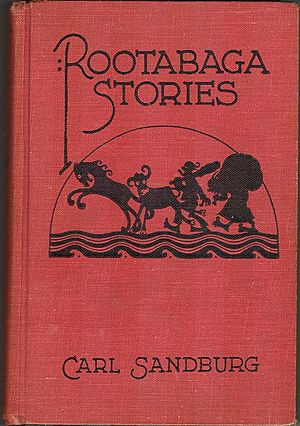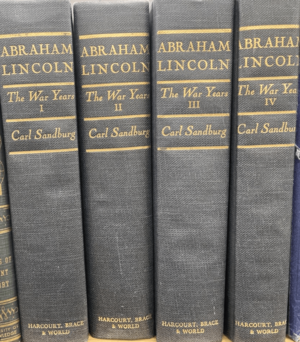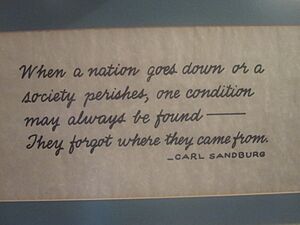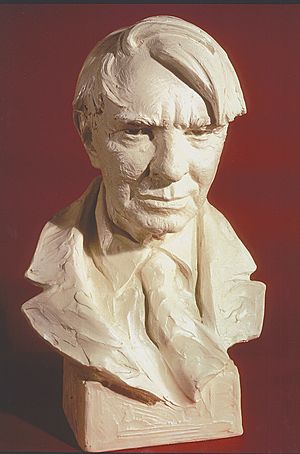Carl Sandburg facts for kids
Quick facts for kids
Carl Sandburg
|
|
|---|---|

Sandburg in 1955
|
|
| Born | Carl August Sandberg January 6, 1878 Galesburg, Illinois, U.S. |
| Died | July 22, 1967 (aged 89) Flat Rock, North Carolina, U.S. |
| Occupation | Journalist, author |
| Alma mater | Lombard College (non-graduate) |
| Notable works |
|
| Notable awards |
|
| Spouse |
Lilian Steichen
(m. 1908) |
| Children | 3 |
| Relatives | Edward Steichen (brother-in-law) Mary Calderone (niece) |
| Signature | |
Carl August Sandburg (born January 6, 1878 – died July 22, 1967) was a famous American writer. He was a poet, a biographer (someone who writes about other people's lives), a journalist, and an editor. Sandburg won three Pulitzer Prizes, which are very important awards for writing. Two of his awards were for his poetry, and one was for his biography about Abraham Lincoln.
Many people thought Sandburg was a major writer of his time. His poems, like Chicago Poems (1916), Cornhuskers (1918), and Smoke and Steel (1920), were very popular. He was loved as a poet because his own life experiences connected him to many different parts of American life. When he passed away in 1967, President Lyndon B. Johnson said that Carl Sandburg "was America."
Carl Sandburg's Life Story
Carl Sandburg was born in a small three-room house in Galesburg, Illinois. His parents, Clara and August Sandberg, were from Sweden. When he was young, he started using the nickname "Charles" or "Charlie." Around the same time, he and his older siblings changed their last name to "Sandburg."
Early Jobs and Education
Sandburg left school at age thirteen and began working. He drove a milk wagon and later worked at a hotel barbershop. He also worked on a milk route again, then as a bricklayer, and even as a farm worker in Kansas.
He attended Lombard College in Galesburg for a while but did not finish his degree. After college, he worked as a hotel servant in Denver and a coal-heaver in Omaha. These experiences helped him understand many different kinds of people and jobs.
Starting His Writing Career
Sandburg began his writing journey as a journalist for the Chicago Daily News. Over time, he wrote many different types of books. These included poetry, history books, biographies, novels, and even children's stories. He also reviewed movies and collected old songs and folk tales.
He lived most of his life in Illinois, Wisconsin, and Michigan. Later in his life, he moved to North Carolina.
Military Service and Marriage
During the Spanish–American War, Sandburg joined the military. He was sent to Puerto Rico in 1898 but never saw battle. He tried to attend West Point, a famous military school, but he left after two weeks because he failed a math and grammar test.
After returning to Galesburg, he went to Lombard College again but left in 1903. He then moved to Milwaukee, Wisconsin, to work for a newspaper. In Milwaukee, he met Lilian Steichen in 1907, and they married the next year. Lilian's brother was the famous photographer Edward Steichen. Carl and Lilian, who he called Paula, had three daughters.
Life in Illinois and Awards
The Sandburgs moved to suburban Chicago, Illinois, in 1912 for his newspaper job. They lived in Evanston before settling in Elmhurst from 1919 to 1930. During this time, Sandburg wrote some of his most famous poetry collections. These include Chicago Poems (1916), Cornhuskers (1918), and Smoke and Steel (1920).
In 1919, he won his first Pulitzer Prize for his collection Cornhuskers. He also wrote three children's books in Elmhurst: Rootabaga Stories (1922), Rootabaga Pigeons (1923), and Potato Face (1930). He also wrote the first two volumes of his biography, Abraham Lincoln: The Prairie Years (1926).
The family moved to Michigan in 1930. Sandburg won another Pulitzer Prize in 1940 for his four-volume work, Abraham Lincoln: The War Years. He received a third Pulitzer in 1951 for his Complete Poems.
Later Life in North Carolina
In 1945, Sandburg moved to a large rural home called Connemara in Flat Rock, North Carolina. He wrote more than a third of all his published works there. He lived there with his wife, daughters, and two grandchildren.
Sandburg supported the Civil Rights Movement. He was the first white person to receive a special award from the NAACP. They honored him as a "major prophet of civil rights in our time."
Carl Sandburg passed away in 1967. His ashes were buried under a large rock called "Remembrance Rock" behind his birth home in Galesburg.
Carl Sandburg's Works
Carl Sandburg was known for his poetry, his biographies, and his children's stories. He also loved and collected folk music.
Poetry and Stories
Much of Sandburg's poetry, like his famous poem "Chicago", focused on the city of Chicago. He worked there as a reporter. He described Chicago as "Hog Butcher for the World/Tool Maker, Stacker of Wheat/Player with Railroads and the Nation's Freight Handler,/Stormy, Husky, Brawling, City of the Big Shoulders."
Sandburg also wrote Rootabaga Stories and Rootabaga Pigeons for children. These were whimsical, sometimes sad, stories he made up for his own daughters. He wanted "American fairy tales" that felt right for American kids. So, his stories featured skyscrapers, trains, and corn fairies instead of kings and knights.
Writing About Abraham Lincoln
Sandburg's multi-volume biography of Abraham Lincoln is very famous. It includes Abraham Lincoln: The Prairie Years (1926) and Abraham Lincoln: The War Years (1939). These books are considered the most popular and widely read books about Lincoln.
His Lincoln books greatly influenced how people saw Lincoln. The books were even turned into a play and a TV show. Many historians believe more Americans learned about Lincoln from Sandburg's books than from any other source. Sandburg won a Grammy Award in 1959 for recording parts of his Lincoln biography.
Folk Music Collector
Sandburg's 1927 book, The American Songbag, was a collection of American folk songs. It was very popular and went through many printings. Sandburg himself was one of the first American folk singers to perform with a guitar. He would sing at his lectures and poetry readings.
Carl Sandburg's Legacy
Carl Sandburg's life and work are remembered in many ways across the United States.
Places Honoring Sandburg
- His childhood home in Galesburg, Illinois, is now a historic site. It has his birth cottage, a visitor's center, and "Remembrance Rock," where his ashes are buried.
- His home in Flat Rock, North Carolina, called Connemara, is also a national historic site.
- Carl Sandburg College is located in his hometown of Galesburg.
- There is a Carl Sandburg Middle School in Fairfax County, Virginia.
On January 6, 1978, the 100th anniversary of his birth, the United States Postal Service released a commemorative stamp honoring Sandburg. The stamp featured a drawing of him and his unique signature.
The Rare Book & Manuscript Library (University of Illinois at Urbana-Champaign) has a large collection of Sandburg's papers. This includes over 600 cubic feet of his photographs, letters, and original writings. In 2011, Sandburg was added to the Chicago Literary Hall of Fame.
Things Named After Sandburg
- Carl Sandburg Village is a large housing complex in Chicago.
- Many schools across the U.S. are named after him. He even attended some of their dedication ceremonies.
- The Carl Sandburg Library in Livonia, Michigan, opened in 1961.
- Sandburg Mall in Galesburg, opened in 1975, is named in his honor.
- The Chicago Public Library gives out the Carl Sandburg Award for contributions to literature.
- A neighborhood in Lawrenceville, Georgia, has streets named after places important in Sandburg's life, like Galesburg Dr and Flat Rock Dr.
- Amtrak added the Carl Sandburg train in 2006. It runs between Chicago and Quincy, Illinois.
Sandburg in Popular Culture
- A sculpture of Carl Sandburg was made by Avard Fairbanks. It is in the Chicago Historical Museum and at Knox College.
- NBC made a six-episode TV show called Lincoln, also known as Carl Sandburg's Lincoln.
- The director Steven Spielberg said that the face of E.T. was partly based on Carl Sandburg.
- Composer Phyllis Zimmerman set Sandburg's poem "Fog" to music in a choral piece.
Images for kids
See also
 In Spanish: Carl Sandburg para niños
In Spanish: Carl Sandburg para niños






